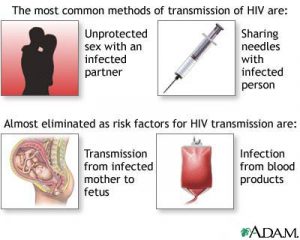Alternate Names : AIDS-related complex – ARC, Chronic symptomatic HIV infection
Definition
Early symptomatic HIV infection is a stage of infection with the human immunodeficiency virus when symptoms are present but AIDS has not yet developed.
See also:
- Acute HIV infection
- Asymptomatic HIV infection
- HIV infection
Overview, Causes, & Risk Factors
Early symptomatic HIV infection has signs and symptoms typical of HIV infection but not full-blown AIDS. The onset of symptoms signals the transition from asymptomatic HIV infection to HIV disease.
At this early stage of HIV infection, the person does not have signs or symptoms of AIDS such as opportunistic infections, certain cancers, or a CD4 count of less than 200.
Risk factors for HIV infection are:
- Being born to an HIV-positive mother
- Receiving a blood transfusion or blood components
- Injection drug use
- Sexual contact with an infected partner in which there is an exchange of semen or vaginal fluids
Pictures & Images
Primary HIV infection
 HIV (human immunodeficiency virus) is more frequently transmitted through unprotected sex or sharing contaminated needles. Transmission from mother to fetus or through blood products has significantly declined in the United States.
HIV (human immunodeficiency virus) is more frequently transmitted through unprotected sex or sharing contaminated needles. Transmission from mother to fetus or through blood products has significantly declined in the United States.
Oral thrush

Oral thrush is characterized by ulcers or lesions in the mouth caused by the yeast fungus Candida albicans. The lesions are painful, slightly raised, whitish in appearance, and cause a dry mouth.
Canker sore (aphthous ulcer)

Canker sores (Aphthous ulcers) are very common. Typically, they are a shallow ulcer with a white or whitish/yellow base surrounded by a reddish border. This ulcer is seen in an individual with AIDS and is located in front and just below the bottom teeth.
Mycobacterium marinum infection on the hand

This bacterial infection is caused by Mycobacterium marinum. Marinum is a relative of the organism which causes tuberculosis. This lesion is often referred to as a swimming pool granuloma. Atypical mycobacterial infections may cause life-threatening disease in people with weakened immune systems (immunocompromised individuals).
Dermatitis, seborrheic – close-up

This is a close-up of seborrheic dermatitis. Note the redness (erythema) and mild scaling. Individuals with AIDS frequently develop seborrheic dermatitis or other types of skin rashes, as seen in this person.
Dermatitis, seborrheic on the face

This is seborrheic dermatitis on the face. Note the redness (erythema) and mild scaling. Individuals with AIDS frequently develop seborrheic dermatitis or other types of skin rashes, as seen in this person who is HIV positive.
Molluscum on the chest

These lesions are associated with the molluscum virus and are present on a person who has a weakened immune system (immunocompromised). Molluscum contagiosum are small, raised, pearly skin lesions caused by the molluscum virus, a member of the poxvirus family. They are seen frequently in children and less often in adults. In adults, they may be considered a sexually transmitted disease. Immunocompromised individuals may experience heavy outbreaks of these lesions, as seen in this photograph.
Molluscum contagiosum on the face

Molluscum contagiosum is most commonly seen in children, however it does occur in adults and may cause extensive infection in people with weakened immune systems. In this photograph, multiple small molluscum are seen covering the cheek, upper neck, and in the sideburn.
Herpes zoster (shingles), disseminated

Herpes zoster (shingles) normally occurs in a limited area that follows a dermatome (see the “dermatome” picture). In individuals with damaged immune systems, herpes zoster may be widespread (disseminated), causing serious illness. Herpes zoster is caused by the same virus that causes chickenpox.
Immune system structures

The immune system protects the body from potentially harmful substances. The inflammatory response (inflammation) is part of innate immunity. It occurs when tissues are injured by bacteria, trauma, toxins, heat or any other cause.
-
Early symptomatic HIV infection : Overview, Causes, & Risk Factors
-
Early symptomatic HIV infection : Symptoms & Signs, Diagnosis & Tests
-
Early symptomatic HIV infection : Treatment



Review Date : 3/2/2009
Reviewed By : David C. Dugdale, III, MD, Professor of Medicine, Division of General Medicine, Department of Medicine, University of Washington School of Medicine; and Yi-Bin Chen, MD, Leukemia/Bone Marrow Transplant Program, Massachusetts General Hospital. Also reviewed by David Zieve, MD, MHA, Medical Director, A.D.A.M., Inc.
The information provided herein should not be used during any medical emergency or for the diagnosis or treatment of any medical condition. A licensed medical professional should be consulted for diagnosis and treatment of any and all medical conditions. Call 911 for all medical emergencies. Links to other sites are provided for information only — they do not constitute endorsements of those other sites. © 1997- 2010 A.D.A.M., Inc. Any duplication or distribution of the information contained herein is strictly prohibited.
